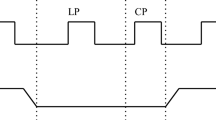Abstract
Delay fault testing using a scan design facilitating two-pattern testing, called Chiba scan testing, requires a long test application time (TAT) compared with well-known delay fault testing. This paper presents an improved Chiba scan testing with short TAT by providing a test compaction. In addition, it presents a test generation for the Chiba scan testing improved by the proposed compaction. Evaluation shows that, for robust path delay fault testing on ISCAS89/ ADDENDUM benchmark circuits, the TAT of Chiba scan testing with the proposed compaction is, on average, 47% and 21% shorter than that of Chiba scan testing without test compaction and that of enhanced scan testing with the conventional test compaction, respectively. In addition, in many cases, the fault coverage of the proposed testing is higher than that of launch-off-capture (LoC) and launch-off-shift (LoS) testing with the same TAT.







Similar content being viewed by others
Notes
Path delay faults that are not sensitizable with LoC [6] need not be tested.
References
Dervisoglu BI, Stong GE (1991) Design for testability: using scan-path techniques for path-delay test and measurement. In: Proc. IEEE int’l test conf., pp 365–374
Krstic A, Cheng KT (1998) Delay fault testing for VLSI circuits. Kluwer, Dordrecht
Namba K, Ito H (2005) Scan design for two-pattern test without extra latches. IEICE Trans Inf Syst E88-D(12):2777–2785
Namba K, Ito H (2009) Test compression for robust testable path delay fault testing using interleaving and statistical coding. IEICE Trans Inf Syst E92-D(2):269–282
Pomeranz I, Reddy SM (1995) Static compaction for two-pattern test sets. In: Proc. IEEE Asian test symp., pp 222–228
Rearick J (2001) Too much delay fault coverage is a bad thing. In: Proc. IEEE int’l test conf., pp 624–633
Reddy LN, Pomeranz I, Reddy SM (1992) COMPACTEST-II: a method to generate compact two-pattern test sets for combinational logic circuits. In: Proc IEEE/ACM int’l conf. comput.-aided des., pp 568–574
Savir J, Patil S (1992) Skewed-load transition test: Part II, coverage. In: Proc. IEEE int’l test conf., pp 714–722
Savir J, Patil S (1994) On broad-side delay test. In: Proc. IEEE VLSI test symp., pp 284–290
Wang LT, Wu CW, Wen X (2006) VLSI test principles and architectures: design for testability. Morgan Kaufmann, San Francisco
Wang W, Gupta SK (1994) Weighted random robust path delay testing of synthesized multilevel circuits. In: Proc. IEEE VLSI test symp., pp 291–297
Acknowledgments
The authors gratefully thank a graduate of our laboratory HaiYing Jin for her valuable comments and suggestions on earlier versions of this paper. This research was partially supported by a grant from CASIO Science Promotion Foundation and the Grant-in-Aid for Young Scientists (B) No. 21700053.
Author information
Authors and Affiliations
Corresponding author
Additional information
Responsible Editor: M. Goessel
Rights and permissions
About this article
Cite this article
Namba, K., Ito, H. Chiba Scan Delay Fault Testing with Short Test Application Time. J Electron Test 26, 667–677 (2010). https://doi.org/10.1007/s10836-010-5177-4
Received:
Accepted:
Published:
Issue Date:
DOI: https://doi.org/10.1007/s10836-010-5177-4




